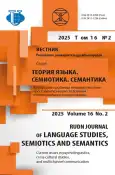Word-Forming Specificity of Diminutives in the Russian and Arabic and its Significance in Translation
- Авторлар: Al-Foadi R.A.1, Zarytovskaya V.N.2
-
Мекемелер:
- University of Baghdad
- RUDN University
- Шығарылым: Том 16, № 2 (2025): Current issues in psycholinguistics, cross-cultural studies, and multichannel communication
- Беттер: 579-595
- Бөлім: FUNCTIONAL SEMANTICS
- URL: https://journal-vniispk.ru/2313-2299/article/view/323532
- DOI: https://doi.org/10.22363/2313-2299-2025-16-2-579-595
- EDN: https://elibrary.ru/EVGPWG
- ID: 323532
Дәйексөз келтіру
Толық мәтін
Аннотация
The word-formation specificity of diminutive vocabulary in Russian and Arabic is considered in this paper. On the background of the fact that the definitions of diminutives in various linguistic traditions do not always reveal the morphological features of this lexical layer, the authors focus on the word-formation motivation in creating diminutives in Russian and Arabic, which becomes the subject of the study. In this regard, special attention is paid to the criterion of O.G. Vinokur and his Arabic parallels are the parameters of the Arabic medieval philologist Ibn Faris, which serve as the basis for revealing the structure and semantics of derivative words in both languages. The authors, resorting to the comparative method, analyze the range of meanings and connotations resulting from the word-formation motivation of diminutive vocabulary in both languages - diminutiveness, endearment, reduction of quantity, including the closeness of time and place specific to the Arabic meaning and amplification of meanings and their expression in both languages. The basics of translating diminutive vocabulary are also not overlooked. Highlighting three important foundations of translation adequacy - structural, semantic and cognitive, which affect the translation process when equivalence is achieved, the authors come to the conclusion about the complexity of the relationship and, accordingly, the translation of diminutives. To do this, the authors in their reasoning leave the sphere of pure linguistics and turn to the culturological sphere, without which today it is unthinkable to talk about a full-fledged translation activity. The work contributes to theoretical linguistics as a comparative study of the Semitic and Slavic languages, and also complements the missing link in the relatively young private theory of Russian-Arabic translation.
Негізгі сөздер
Авторлар туралы
Raheem Al-Foadi
University of Baghdad
Хат алмасуға жауапты Автор.
Email: raheem.ali@cis.uobaghdad.edu.iq
ORCID iD: 0000-0001-8699-9596
SPIN-код: 2228-3794
Dr.Sc. (Philology), Associate Professor of the Russian Language Department, College of Languages
Bab Al-Mudam, Baghdad, Republic of Iraq, 10047Victoria Zarytovskaya
RUDN University
Email: widaad@yandex.ru
ORCID iD: 0000-0001-9910-7913
SPIN-код: 4434-9391
PhD in Philology, Associate Professor of the Department of Foreign Languages, Faculty of Humanities and Social Sciences
6 Miklukho-Maklaya St., Moscow, Russia, 117198Әдебиет тізімі
- Al-Azhari, A.K. (2006). Explanation of the statement on the clarification. Beirut: Dar al-kutub al-‘ilmiyyah (In Arab.).
- Al-Suhaili, A. (1992). The results of thinking in Syntax. Beirut: Dar al-kutub al-‘ilmiyyah. (In Arab.).
- Al-Istrabadhi, A.R. (1982). The explanation of Shafia Ibn Al-Hajeb. Beirut: Beirut: Dar al-kutub al-‘ilmiyyah. (In Arab.).
- Al-Jurjani, M. (2003). Definitions. Beirut: Dar al-kutub al-‘ilmiyyah. (In Arab.).
- Safonova, E.V. (2008). Case valencies of the Arabic and Russian verbs. Author. dis. … cand. philol. Sciences. Moscow: RUDN University. (In Russ.). EDN: NKQMAD
- Alexandrova, O.I., & Abdalrakhman, M.Kh. (2017). Genitive case in the grammatical systems of Russian and Arabic. Bulletin of the Vyatka State University, 9, 89–92. (In Russ.). EDN: ZRIVSF
- Unezheva, M.K. (2016). Difficulties encountered by Arab students in the study of the case system of the Russian language. Philological Sciences. Questions of theory and practice, (11), Part 1, 202–205. (In Russ.).
- Vinokur, G.O. (1959). Notes on Russian word-formation. Selected works on the Russian language. Moscow: Uchpedgiz, 419–442. (In Russ.). EDN: WTIEVF
- Ibn, Faris. (1979). Dictionary of Language Standards. Amman: Dar al-fikr. (In Arab.).
- Jabal, M.H. (2006). The theoretical and practical derivation. Cairo: Maktabat al-adab. (In Arab.).
- Al-Foadi, R.A., & Mingazova, N.G. (2018). The three-level phono-grammar order and its derivational connecting link: The elements of language system (on the material of Arabic). XLinguae, 11(4), 59–77. https://doi.org/10.18355/XL.2018.11.04.06 (In Russ.). EDN: NDIZNF
- Arabiat, R.M., & Al-Momani, I.M. (2022). Diminution in Arabic: A suggested strategy to Mona Baker’s non-equivalence problem “differences in form”. Journal of Language and Linguistic Studies, 18(1), 85–93. https://doi.org/10.52462/jlls.168
- Grande, B.M. (2001). The course of Arabic grammar in comparative historical coverage. Moscow: Vostochnaya Literatura RAN.
- Al-Foadi, R.A., Zarytovskaya, V.N., & Al-Roznamachi, R.H. (2021). Motivation of Word Formation in Russian and Arabic Languages and its Role in Achieving Translation Equivalence. RUDN Journal of Language Studies, Semiotics and Semantics, 12(3), 652–668. https://doi.org/10.22363/2313-2299-2021-12-3-652-668 (In Russ.). EDN: RNNQZG
- Karam, R.A. (2009). Word-formation structure of zoocomposites with a verbal basis in languages of various types. Bulletin of the Voronezh State University. Series: Linguistics and intercultural communication, 2, 105–109. (In Russ.). EDN: KYSEYJ
- Hazim, K. (1998). Infletion of names. Baghdad: Maktabat al-adab. (In Arab.).
- Bin Mukhashin, Kh. (2018). Diminutives in English and Hadhrami Arabic. Journal of Humanities, 15 (1257–266), 257–266.
- Nakshabandi, A. (1996). Diminutives in classical Arabic and the urban Hijazi dialect. Linguistic Communication Periodical,7, 1–15.
- Karpov, I.A. (2003). Literalism of ancient translations of the Bible and the problem of adequate transmission of the semantics of the source text. Bulletin of VSU. Series Linguistics and International Communication, 2, 45–49. (In Russ.). EDN: PKIJVB
- Komissarov, V.N. (1990). Translation theory (linguistic aspects). Moscow: Vysshaya shkola. (In Russ.).
- Steiner, R. (1994). Philosophy, cosmology and religion: Ten lectures given at the Goetheanum in Dornach, Switzerland, Sept. 6–15, 1922. New-York: Anthroposophic Press.
- Komissarov, V.N. (2000). Modern translation studies. Moscow: ETS. (In Russ.).
- Shokataeva, R.S. (2013). Perception as a cognitive operation in cognitive-reproductive translation activity. Questions of cognitive linguistics, (4), 45–50. (In Russ.). EDN: RIVQXT
- Pym, A. (1992). Translation and Text Transfer: An Essay on the Principles of Intercultural Communication. Frankfurt am Main: Peter Lang.
- Zlobin, A.N. (2009). On the problem of the intercultural component of translation competence. Questions of cognitive linguistics, (4), 129–139. (In Russ.). EDN: KYSIZJ
Қосымша файлдар









